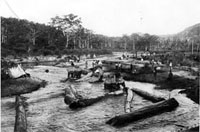| Floating Forests (excerpt) |
 |
 For the stuff
of romance, few sagas can match the portrait of men at work in Thailand's
teak forests. Even long after the forests have fallen silent, the
image of men dwarfed by huge elephants dragging logs through tiger-infested
mountains to reach the rivers, still resonates in the public mind.
The vision is kept alive through elephant-back safaris in thick
rainforests and the occasional sighting of log rafts being towed
down the Chao Phya River… For the stuff
of romance, few sagas can match the portrait of men at work in Thailand's
teak forests. Even long after the forests have fallen silent, the
image of men dwarfed by huge elephants dragging logs through tiger-infested
mountains to reach the rivers, still resonates in the public mind.
The vision is kept alive through elephant-back safaris in thick
rainforests and the occasional sighting of log rafts being towed
down the Chao Phya River…
…For centuries, Thais had been restrained in their use of the forests. They cut trees to build homes and temples, but in small amounts that barely dented the forest's resources. The late 19th century, however, saw the start of an undertaking which would have a profound impact on Thailand's rivers: teak exports. In 1825, John Crawfurd had seen tremendous potential for the trade: "The Teak forests of Siam appear, by all accounts, to be considerable... [and] will, in all probability, become a valuable article of trade in our intercourse with the Siamese." It took another half century before his prediction would be realized…
…All four tributaries-but principally the Ping, Wang, and the Yom-served as natural flumes to float the logs from the northern forests to Bangkok and from there to markets in Europe that prized the hardwood. The job of moving the trees from the forest floor to the rivers' margins fell to elephants captured in the rainforests and trained for the task. Even when mechanized vehicles became available, sure-footed elephants capable of maneuvering on steep slopes and in narrow defiles continued to be the preferred mode of transport.
At the water's edge, the logs were rolled into the river and left to make their way downstream, a process called ploi khwai (release the buffaloes). With the annual rise and fall of the river, logs would become stranded on the riverbanks or stuck in massive jams that only dynamite could clear. An article in the October 1900 issue of the Bangkok Times underscored the magnitude of the jams:
In connection with the recent Chiang Mai Consular report emphasizing the importance of good floating seasons at the present juncture, it may be of interest to mention that there are at present 30,000 logs of teak blocked at the entrance to the rapids [Kaeng Soi, now beneath the Bhumibol Dam reservoir]. They comprise practically a year's delivery and probably will have to be shifted by elephants.
Given the number of logs and the sharp fluctuation in water levels, it is estimated that a log cut high up the river could take up to five years to reach the downstream marshaling areas. Lakhon (Lampang) on the Wang, Raheng on the Ping, Phrae and Sawankhalok on the Yom, and Paknampho (Nakhon Sawan) on the Chao Phya owe their prosperity to their roles as assembly points where free-floating logs were bound into rafts for the journey to Bangkok.
Logs were bundled into two types of rafts. If the river was narrow and winding, they were tied in the phae mai sak bap nguu sai (Teak Raft like a Writhing Snake) which was wider at the back than at the front. In a broad river, the logs were gathered into a phae mai sak plaa taphian (Teak Raft like a Taphian Fish) which was wide in the middle and narrow at the ends. As a raft rounded a bend, an anchorman would secure a line to the inner bank so that the raft could swing in an arc without colliding with the opposite shore.
Eventually, the raft reached the sawmills on the northern and southern outskirts of Bangkok where they were cut into planks for local consumption. Soi Rong Luae (Sawmill Lane), off lower New Road, is a reminder of former days. If the logs were destined for overseas buyers the rafts were towed to Bangkok proper where they were loaded aboard ships for the voyage to Europe...
|



